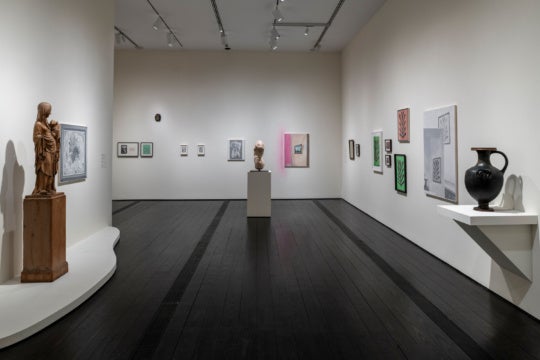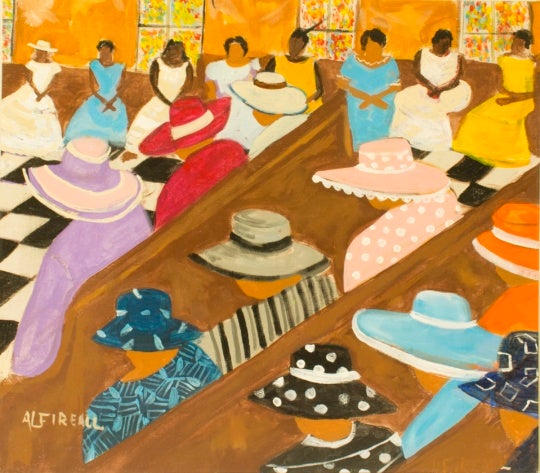
Rashaad Newsome’s recent exhibition Orders of Chivalry at the SCAD Museum of Art in Savannah was as magnanimous as it was egalitarian, as reverential as it was irreverent in its synthesis of high and low forms. A kind of “mini-retrospective,” according to the New Orleans born, New York-based artist (b. 1979), the exhibition succeeded at thoughtfully gathering the thematic breadth of his distinctly complex and subversive artistic practice. Collaborating with the artist throughout its conceptualization and execution, curator Aaron Levi Garvey ably negotiated the challenge of coherently staging a dozen difficult, monumental objects that scrutinize power structures by overwhelming viewers’ visual fields and defying the logical order of their mediums.
Abounding rituals, symbols, and metonyms allude to archetypes of race and class, hip hop culture, queer identity, the body, wealth, glamour and more in the Heraldry trilogy, a set of three videos shown in an immense installation that anchors the exhibition. As seen on three sizeable, rear-projection video screens encased in absurdly ornate custom frames, Newsome endures the rites and rituals of becoming the highest-ranking knight: the king of arms. Aptly, King of Arms is the title of the SCAD Museum-commissioned installation, as well as that of a 2013 New Orleans Museum of Art exhibition that prompted and conceptually anticipated Orders of Chivalry. The three screens, substantial enough to encompass most of the visual field even at a generous viewing distance, were installed on three walls inside a room built in the center of the gallery. On the fourth wall inside the structure, the bejeweled coronation orb, scepter, flat-brim cap-crown and tabard that Newsome acquired in the videos were proudly arranged. The leather crown and tabard are studded with jewels and emblazoned with stars, magnolia flowers, and fleurs-de-lis, and the Winged Victory atop the scepter is a black woman in a flowing dress.

Sculptural collages were hung on the exterior walls of the video installation, compelling a processional path of motion around the cube. Frames adorn the collages, too; some are customized antiques, others hand fabricated and site specific, and many are made with extravagant materials running the gamut from mahogany to bands of Gucci fabric. The frames are fine, intricate, and even delicate despite their shameless and purposeful gaudiness. Marvels of craft, luxuriance, and volume in their own right, they struggle to contain within them explosions of geometric patterns, fleurs-de-lis, bees, magnolias, mouths, jewels, gold chains, watches, cars, and, here and there, actual explosions.
In this volatile sense, Newsome’s work is truly Baroque, a term long associated with his oeuvre. More than evoke dynamism, energy, and embellishment, his Baroque sensibilities function as a crucial visual device. Even when collages impose geometric structure or recall anthropomorphic forms, their many insistent details break away from the surface and its attempt to maintain order. The sculptural collages, each commanding their own space and each with a distinct presence, conjure the sublime as their absurd and glitzy parts defy the plane’s limits, as if the content of their argument was too energetic for logic to bear. The works of Orders of Chivalry impart an aura of majesty, yet frustrate and exhaust perception.
With complex aesthetic devices, a dense constellation of thematic connections, and a deep historical consciousness, Newsome thus probes the language of power and how people and groups present themselves authoritatively. Somehow, these convoluted representations of power dynamics articulate a regard for that cacophony, at which Newsome has hinted. Setting compositional elements, identities, and signs in opposition, he celebrates the effort we take to form ourselves by challenging who has and has not historically owned that privilege.
Jared Butler is a writer and critic based in Atlanta.




